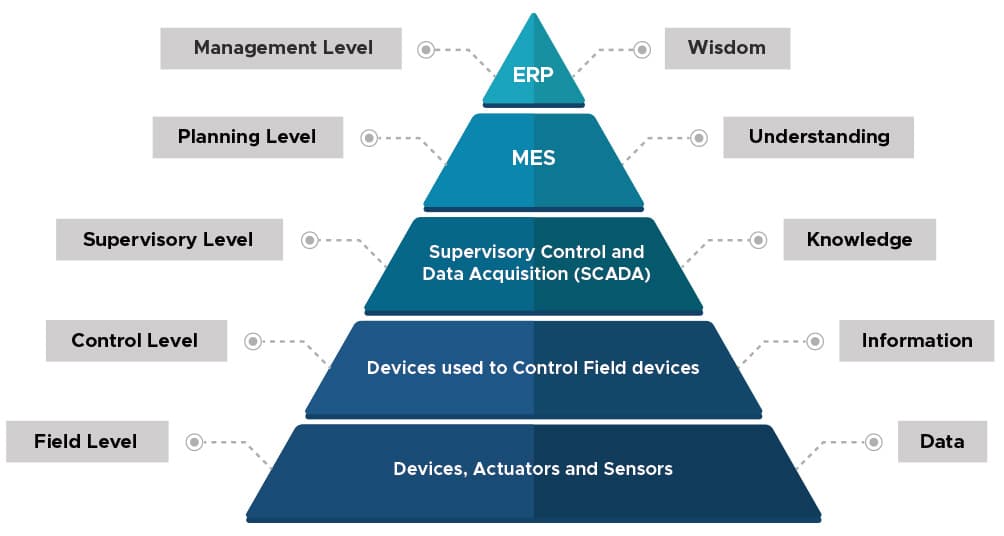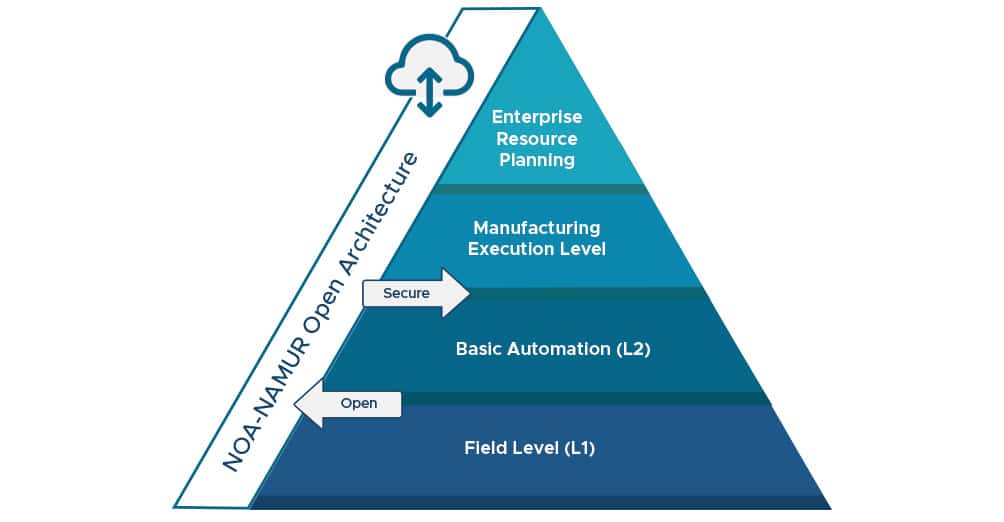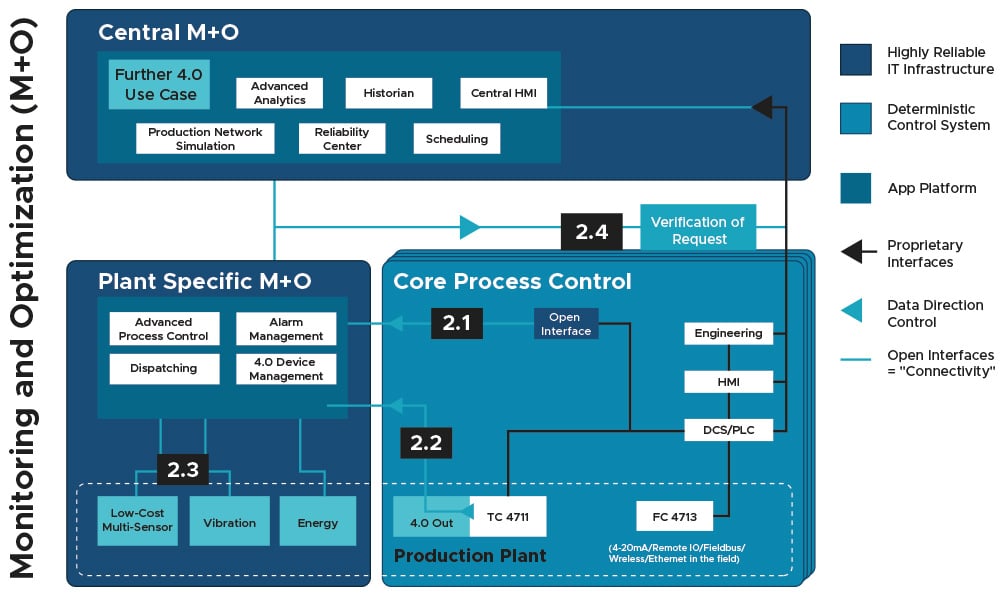Secure remote access to valve data and health information according to NAMUR standard
Industrial facilities are an epicenter for data generation. From the ERP down to the Field Level, countless pieces of data are floating around in real-time. Putting it to good use paves the road to unlocking the potential of critical devices, such as valves, over time. Today, the NAMUR standard is one of the go-to measures for secure remote access to valve data and healthy intelligence. The regulation excels at preserving integrity against threats from unauthorized sources.
Touching on the NAMUR guidelines is increasingly relevant in these times of Industry 4.0-fueled changes. So let’s review how it works. Afterward, you will be better equipped to protect your valve data from intruders. And, by default, your process.
Automation structure in the process industry
The minute you set foot in a refinery, you can tell it is a complex and dynamic setting. High levels of precision and accuracy are indispensable for meeting targets.
In my eyes, this first impression is a constant for process facilities everywhere. Because of that, the technology deployed to control and monitor what happens in the field must measure up to the task. Such is the purpose of the automation structure.
Going by the book, the automation structure consists of sensors, controllers, HMIs, and software working together to automate the process. When linked to mechanical components such as valves and manifolds, the process becomes more reliable. Thus, the capacity to maintain uptime while avoiding accidents or incidents improves.
For plant operators, this is the foundation to ensure resilience, safety, and efficiency.
Since the automation structure devices are dispersed around the process plant, tons of information is available for reading and analysis. The amount is so overwhelming that it can be easy for plant operators to miss critical warning signs.
What can be done to solve this issue?
The front-runner option that I recommend is implanting a remote access framework.
Here is a solution that lets stakeholders act in unison without disturbance. Consequently, the cooperation between vendors, system integrators, and even maintenance teams strengthen. Especially when thinking of mechanical components.
I know of two approaches to making a swift transition to a remote access-powered automation structure. Let’s check what the best option is for mechanical components like valves and manifolds:
Automation pyramid
The automation pyramid is the original framework set up to design and install an automation structure. The model features a hierarchical level breakdown according to functionality and insight gathered:

Fig. 1. Classic automation pyramid structure.

Fig. 2. Insight provided by each level of the automation pyramid structure
The automation pyramid once proved effective for engineers to accomplish vital missions:
Careful and accurate
monitoring of the devices.
Troubleshoot problems faster and more assertively.
But now it is falling short. It is becoming dated and limited.
A root cause is that current standards have broadened the automation requirements in the context of Industry 4.0. Thus, modern process plants have a growing number of devices to integrate. These developments also imply new security measures for data protection.
What can you do next?
Design and implement automation systems according to a new method.
I’m talking about the NOA approach.
NAMUR open architecture
Are you designing a new process plant? Or maybe you are planning an upgrade to welcome digitization. Is that it?
Either way, learning about the NAMUR open architecture is important for you.
Here’s an approach that is all about creating a modern framework for automation systems based on open architectures and protocols. The catch is that it works alongside the classic automation pyramid we all know and love while enabling cutting-edge technologies such as big data, IIoT, cloud computing, and Industry 4.0.
As you can expect, the benefits of the old model remain as new technologies get into the mix. This is possible through an action mechanism backed by precision-defined data channels.
In NOA, field devices like sensors and actuators get linked to a “secondary communication channel.” Such a portal is open for digital data export and sharing. IT secures the whole exchange process without affecting the original automation structure. The concept is exciting and neat, if you ask me.
What good comes from it?
- The bottom and the top of the pyramid communicate without risking operations—a win-win case for stakeholders.
- Stakeholders access extra data that is handy for process improvements.
- Enhanced knowledge about the asset blossoms.
- Steadier operations prevail.
- Maintenance interventions move toward the predictive and preventive side.
- More focused and informed personnel about their process show up to work each day.
How are mechanical components such as valves and manifolds integrate into NOA?
They can join the plant’s digital twin environment in a seamless manner. For example, if the operator happens to have any of our suitable products installed, they can use AS-Schneider’s Digital Valve Kit (DVK) app for dynamic valve data capture.
Have a look at the representation of the NOA pyramid below. Notice how the new open and secure architecture set up by NAMUR (left pink area) doesn’t affect the original automation framework (gray area).

Fig. 3. NOA pyramid
Let’s contextualize the image with regard to our physical assets—in this case, the automation structure of a process plant.
The gray area is where the core process automation for control unfolds. The staggered gray tabs indicate that a system can also be implemented in a modular manner.
The parallel pink area serves for the monitoring and optimization of the plant. The functions located there are not used for direct process control. They are restricted to monitoring or optimizing the plant. Here are also the mechanical components, such as valves and manifolds.
I’ve already addressed how the new monitoring data flows through specific channels and that field devices require a secondary channel for data transfer. But there’s much more to tell about NOA. So, let’s continue.
Structure and data streams in the NOA architecture
As mentioned before, NOA is able to distinguish the two structures at play:
Main automation structure
for core process control
(CPC).
Open system world for monitoring and optimization tasks (M+O).
By means of open interfaces such as OPC-UA, performing data export from the existing CPC to the system world for monitoring and optimization tasks is a go. Because of that, increased tracking and overall improvements take place.
As per the company’s convenience, the installation of the M+O functions can be plant-specific or off-premises. The latter is advantageous when the data converges across plants or locations.

Fig. 4. Structure and data streams in NOA (interactions between CPC and M+O functions)
If, by any chance, more sensor signals are necessary, the open system collects them from field devices. Under one condition, though. The field devices must already have a connection to the second communication channel.
I must highlight that the addition of extra sensors to the open system is not a liability. NOA has the capability to facilitate this kind of integration without causing upset.
What else does NOA bring to process plants?
Further benefits of the NAMUR open architecture
#1. Resilience
New monitoring and optimization tasks no longer must measure up against the strict criteria of core automation.
#2. Lower automation availability requirements for process optimization
The enriched interoperability gathered allows plant operators to carry out their job with almost 0 restraint.
#3. Cost reduction
By using standardized components and systems and having access to valuable data extracts, plant managers can:
- dive into predictive maintenance for better uptime,
- boost yield,
- enhance product quality,
- adjust energy consumption based on the actual requirements, and
- lower the total cost of ownership of automation technology (no integration or customization).
#4. Improved overall efficiency
Processes and workflows are easier to streamline. Thus, productivity blossoms and downtime hits rock bottom.
How to integrate mechanical components into the NOA framework
I want to use a practical example of how mechanical components integrate into the NOA framework. And what better way to do it than through valves and manifolds? Two abundant and crucial mechanical components for the process industry.
To make it more interesting, I’m going to show you how you can leverage NOA to reduce costs from additional instrumentation.
But first, a little background is necessary.
Prior to the current digital revolution, which has enabled prompt means to communicate and exchange data, process industry operations ran more “locally and manually.”
Plant operators knew what was happening by making rounds during each shift or by looking at the control panel. Top management levels or investors were partially sidelined by the action. They had to wait a little longer to receive the detailed report for the day or shift.
To add more fuel to the fire, at times, the information received could have been subject to human error. The situation worsened when the assets were numerous and spread across distant locations.
Those are a few reasons why remote access to data has become so utterly important today.
Having the ability to access data using a computer or mobile device without even being on-site means that any authorized stakeholder can look at critical data such as
- health status,
- maintenance requests, and
- safety indications.
Consequently, that stakeholder can dictate actions to improve the process in real-time—from anywhere in the world.
Now, back to our example.
Functional app like AS-Schneider’s DVK
The data in question comes from the control valves and manifolds at two-stage compression trains with a high availability requirement. In this case, a functional app like AS-Schneider’s DVK can make a huge difference.
Why?
To meet the availability request and vouch for operational safety, the stakeholder can ask for extra measurements on the control valves and manifolds. This addition will be low cost since the sensors are not required for the core process control, I may add.
Through the app, the stakeholder gains new M+O data that will help launch future programs based on reliable predictions from the new measurements.
In other words, by having insight into the assets’ future behavior and eventual shutdown dates, downtime can be prevented and output improved. Without adding new automation components. Just with the new extra measurements from the field devices.
As you can see, there’s more control over mechanical components and expanded knowledge for a performance boost.
Security measures in NOA
The beauty of NOA’s design is that it comes with suitable methods and appropriate security measures to ensure that the functions from the M+O area do not impair the CPC area.
If any stakeholder wants to influence the core automation, e.g., by a command request, such a call must be checked and released by a new “Verification of Request” function. Should it proceed, changes in value ranges, plausibility checks, or dialog with the operator must precede the officialization.
By opening a second communication channel and warranting secure access gateways, standardized models, and verifications, plant operators can rest assured about the protection of their process plants.
Outro
The next level of operational excellence for process plants is here. And it happens to rely on digital technologies that support remote access to data and unrestricted frameworks, such as the NAMUR open architecture.
NOA is the ideal complement to integrate into a process plant the latest IT solutions alongside the original automation structure. The framework works on greenfield and brownfield sites alike, offering broader measurement capabilities to enhance monitoring and optimization functions.
Through acute monitoring of field devices and mechanical components, plant operators become more attuned to making process optimizations that lead to:
- reduced OPEX,
- improved energy consumption,
- boosted uptime,
- enhanced product and process quality,
- lower cost of ownership, and
- happier, more productive personnel.
As these changes take place in the monitoring and optimization area, aka the NOA space, the plant’s core process control and its automation structure remain untouched and fully secured.
What do you say? Are you ready to wave goodbye to incomplete and unstructured data? Then it sounds like NOA and remote monitoring are the forthcoming steps you should take.
And my last hint for you: Read my other article, too: Asset performance management of mechanical components by industry 4.0 app!
Cheers!
Image Source: © Mr.B-king (Adobe Stock) & AS-Schneider

